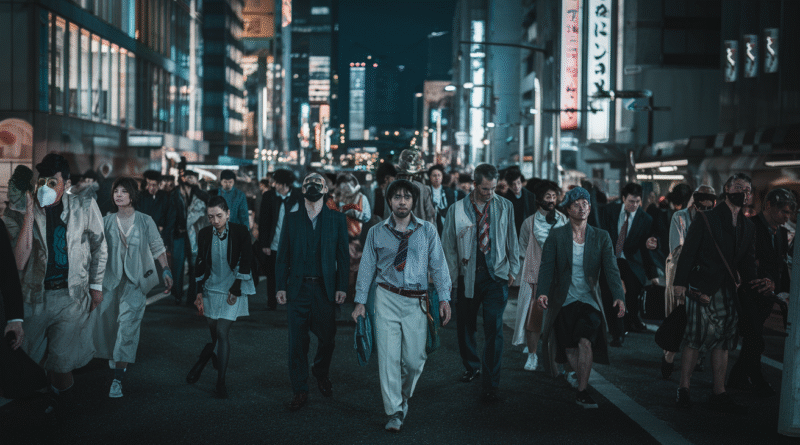The Unexplained Sleepwalking Epidemic in Japan : A Strange Phenomenon Unfolding
Japan, renowned for its bustling cities, rich traditions, and technological innovations, has recently been gripped by a strange and unsettling phenomenon—a widespread sleepwalking epidemic. Initially quiet and isolated, the epidemic has now spread across various regions, affecting individuals from all walks of life and causing growing concern. But this isn’t just any case of sleepwalking, and experts are scrambling to understand its baffling nature.
What’s happening in Japan in 2024, and why is this epidemic sparking so much alarm? This in-depth look at the mystery explores the rise of the sleepwalking epidemic, the personal accounts of those affected, and the possible causes that doctors and researchers are trying to uncover.
The Outbreak of the Epidemic
The first reports of strange sleepwalking incidents began in late 2021, but it wasn’t until mid-2022 that authorities started paying attention. At first, these incidents were brushed off as random, isolated cases. However, as the number of reports steadily increased and spread across different parts of Japan, it became clear that something unusual was happening.
By 2023, hundreds of cases had emerged across the country, from rural villages in Hokkaido to the streets of Tokyo. People of all ages, genders, and professions started experiencing sudden bouts of sleepwalking, many of whom had never sleepwalked before. Disturbingly, these episodes weren’t limited to wandering around at home—some people were found walking outside, driving vehicles, or engaging in bizarre behaviors while asleep.
Unusual Characteristics of the Sleepwalking Epidemic
One of the most perplexing aspects of this epidemic is the uniformity of symptoms among those affected. Typical sleepwalking, or « somnambulism, » usually involves simple tasks like walking or talking while in a deep sleep, unaware of one’s surroundings. However, the cases in Japan go far beyond this.
People have been discovered driving long distances, visiting unfamiliar places, or performing complex tasks, such as operating machinery, all while still asleep. These types of behaviors are rare in typical sleepwalking cases, adding to the mystery of what’s happening.
One notable case involved a man in his thirties from Nagano Prefecture who was found stacking rocks outside his home in the middle of the night. He had no memory of the event, and what made it stranger was that he had never shown interest in such activities before. Another case involved a woman who drove 30 kilometers while asleep, only to park in an unfamiliar village. Local residents found her still asleep behind the wheel.
Many of those affected report waking up feeling disoriented and exhausted, with no recollection of their actions. Some experience multiple episodes in one night, while a few individuals have been seen sleepwalking while standing or sitting motionless, staring into space for extended periods—a disturbing sight for those around them.
The Epidemic’s Impact on Society
As the epidemic spread, its impact on society became evident. Families were frightened by their loved ones’ unpredictable behavior. Spouses and partners woke in the middle of the night to find their significant others attempting to leave the house or engage in strange tasks while unconscious. Many households began locking doors not to keep intruders out, but to prevent sleepwalkers from wandering off.
Employers also noticed the effects. Several incidents involved employees arriving at work in a dazed state, unable to explain how they got there. Factories and companies with night shifts grew concerned, implementing stricter safety measures. Reports of nighttime accidents increased, prompting public safety campaigns to protect sleepwalkers and those around them.
By 2024, the sleepwalking epidemic had attracted international attention. Sleep specialists and doctors from around the world flocked to Japan to study the cases. Conferences were held to exchange findings, yet the cause of the epidemic remained elusive. Most unsettling of all, the phenomenon showed no sign of slowing, despite various treatments and interventions.
Personal Stories: Life in the Epidemic
Personal accounts from those affected highlight the confusion and fear that surround the epidemic. For some, the sleepwalking episodes are an odd inconvenience, while for others, they’ve become a serious disruption to everyday life.
Hiroshi Sato, a 45-year-old businessman from Osaka, is one such case. For most of his life, Hiroshi had no issues with sleep, but in 2023, his wife found him sitting in the dark, mumbling to himself. She initially thought he was awake, but when she asked him what he was doing, he didn’t respond. He stood up and tried to leave the house, still unresponsive. This happened repeatedly over the year, and doctors have yet to find an effective treatment.
Another striking case is that of Miyuki, an 18-year-old high school student from Tokyo. After experiencing no sleep issues her entire life, Miyuki’s mother found her trying to cook while asleep one night in 2024. Frightened, the family sought medical help, but the episodes only worsened. One night, Miyuki even tried to climb onto the roof. She remembers none of these events and now dreads going to sleep.
Investigating the Causes
With the sleepwalking epidemic continuing to grow, researchers are racing to find potential causes. Some experts suspect that Japan’s high-pressure work culture and the stresses of modern life could be a contributing factor. Japan is known for its demanding work environment, and sleep disorders tend to be more common in societies where overwork and stress are prevalent. As people face increased stress and longer work hours, the quality of their sleep deteriorates.
Still, stress alone doesn’t fully explain the complex behaviors seen in these sleepwalking episodes. Some researchers are exploring the possibility that environmental factors, such as pollution, electromagnetic interference, or even food additives, might be triggering the phenomenon. Others point to the rising use of technology, particularly smartphones and screens, which have been linked to disruptions in sleep patterns and may be influencing abnormal sleep behaviors.
Another theory suggests a potential connection between the epidemic and neurodegenerative diseases like Alzheimer’s or Parkinson’s. Although most cases involve younger individuals, some researchers speculate that undiagnosed neurological conditions might be contributing to abnormal sleep behavior.
More extreme theories have surfaced online, with some speculating about supernatural causes, secret government experiments, or extraterrestrial involvement. While these ideas lack scientific backing, they reflect the anxiety and confusion the epidemic has stirred among the population.
The Medical Community’s Response
The medical community has been working tirelessly to uncover the cause of the epidemic. Sleep specialists have conducted studies on affected individuals, monitoring brain activity during their sleepwalking episodes. Some have found irregularities in brain waves, but the results have been inconsistent across patients.
Despite extensive research, no definitive cause has been identified. Treatments such as cognitive-behavioral therapy (CBT), medication, and improved sleep hygiene have been applied with varying success. While some patients have seen a decrease in episodes, others continue to experience them regularly. Many doctors believe the epidemic may be the result of multiple factors, both biological and environmental.
Looking Ahead
As Japan progresses through 2024, the sleepwalking epidemic shows no signs of stopping. With no clear cause or cure in sight, those affected continue to struggle with the mysterious phenomenon. While some individuals have managed to manage their sleepwalking episodes, others live in fear of what they might unknowingly do while asleep.
The long-term effects of the epidemic on Japanese society remain unclear, but it has already spurred important research into sleep disorders. If a solution is found, it could provide valuable insights into the mysteries of the human brain and sleep. Until then, Japan remains at the center of a perplexing and eerie epidemic—one that may change our understanding of sleepwalking forever.
For now, the affected individuals can only wait and hope for answers as the strange phenomenon continues to disrupt their nights.

